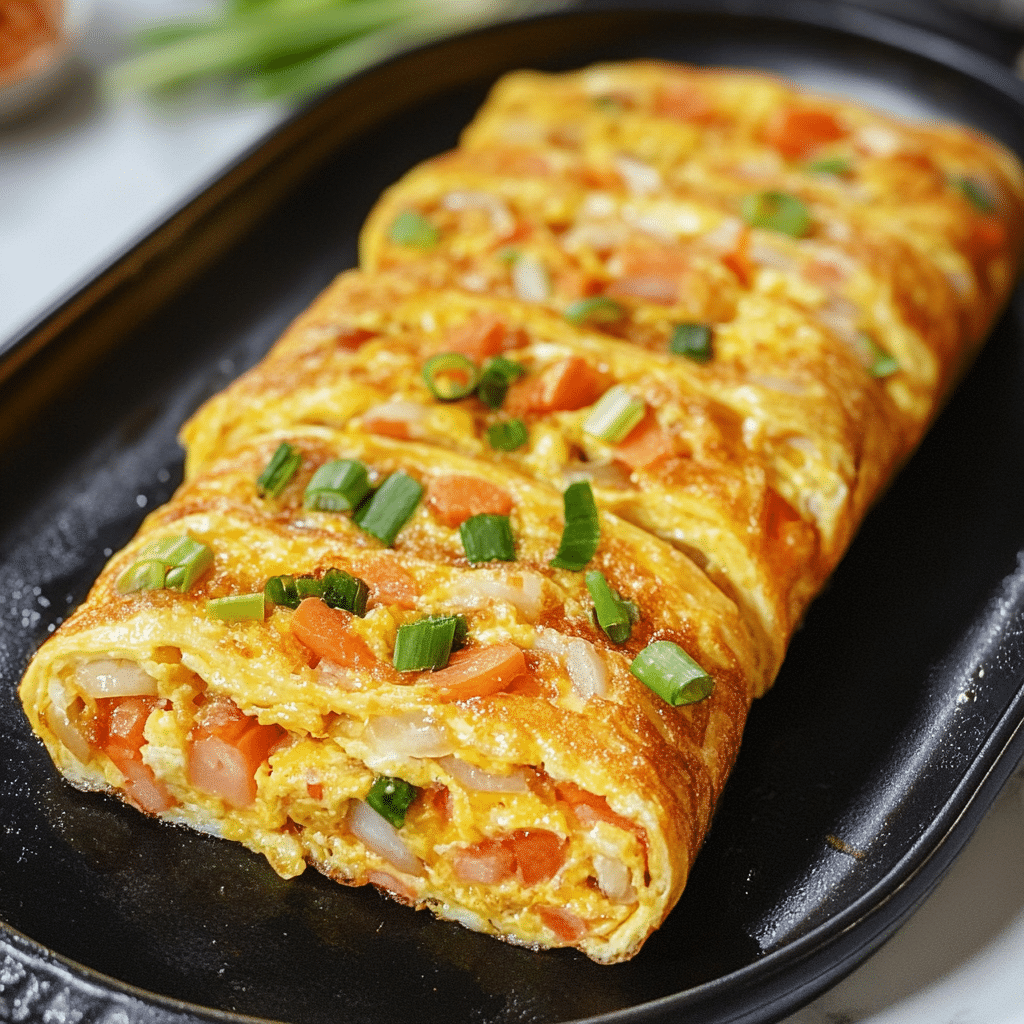If you’ve ever wondered how to create a light, fluffy, and perfectly layered breakfast treat, our easy guide to making Korean Rolled Omelette will become your new favorite kitchen adventure. This classic Korean dish, known as gyeran mari, stacks soft eggs into delicious rolls packed with flavor and texture. Whether you’re serving it as a quick morning bite or a savory snack, mastering the Korean Rolled Omelette is sure to brighten up your cooking routine with its vibrant taste and beautiful layers.
Why You’ll Love This Recipe
- Simple Ingredients: This dish requires only a handful of everyday items that come together beautifully.
- Fluffy Texture: The layered rolling technique creates a tender, airy omelette every time.
- Customizable Flavors: Easily add vegetables, herbs, or proteins to suit your taste.
- Quick to Make: Ready in under 15 minutes, perfect for busy mornings or snacks.
- Eye-Catching Presentation: Its bright yellow spiral adds a pop of color to any meal.
Ingredients You’ll Need
Each ingredient in the Korean Rolled Omelette plays a crucial role in achieving the perfect balance of flavor, color, and texture. Using fresh, quality eggs is key, while simple seasonings and optional add-ins bring depth and personality to your dish.
- Eggs: The base ingredient, providing richness and fluffiness when mixed and cooked carefully.
- Salt: Enhances the natural flavor of the eggs without overpowering them.
- Sugar: Adds a subtle sweetness that balances the savory components.
- Vegetables (optional): Finely chopped green onions or carrots for freshness and color.
- Oil or Butter: For a non-stick surface and to add flavor while cooking.
Variations for Korean Rolled Omelette
One of the joys of the Korean Rolled Omelette is how easy it is to adapt. You can experiment with flavors or accommodate dietary preferences by switching up the ingredients without losing the familiar comforting quality.
- Cheese Addition: Melt in some shredded cheese before rolling for an extra creamy bite.
- Vegetarian Style: Add chopped spinach, bell peppers, or mushrooms for a veggie-packed omelette.
- Spicy Twist: Sprinkle gochugaru (Korean red pepper flakes) or finely chopped chili for some heat.
- Protein Boost: Include cooked shrimp, ham, or tofu cubes for a heartier meal.
- Gluten-Free: Keep it naturally gluten-free by sticking to eggs and fresh vegetables.
How to Make Korean Rolled Omelette
Step 1: Prepare the Egg Mixture
Crack your eggs into a bowl and whisk them together until smooth. Add a pinch of salt and a small amount of sugar to balance flavors and promote browning when cooked. If you want, fold in finely chopped green onions or carrots now for a colorful, fresh touch.
Step 2: Heat Your Pan and Add Oil
Choose a non-stick pan or a traditional rectangular tamagoyaki pan for the best rolling experience. Heat it over medium-low heat and coat evenly with a light layer of oil or butter to prevent sticking.
Step 3: Cook in Thin Layers
Pour a thin layer of the egg mixture, just enough to cover the pan’s surface. Wait until the eggs are nearly set but still a bit soft on top. This ensures it will roll without breaking.
Step 4: Roll the Omelette
Starting at one edge, gently roll the egg toward the opposite side using chopsticks or a spatula. Leave the rolled part at one end of the pan.
Step 5: Add More Egg Layers and Continue Rolling
Pour another thin layer of egg into the pan, lifting the rolled omelette slightly so the fresh egg flows underneath it. When this layer is partially cooked, roll again, combining the layers. Repeat until all egg is used.
Step 6: Shape and Slice
Once the final roll is cooked through, press it lightly with a spatula to shape it into a neat log. Let it cool for a minute, then slice into bite-sized pieces to reveal beautiful spiraled layers inside.
Pro Tips for Making Korean Rolled Omelette
- Low and Slow: Cook on medium to low heat to avoid browning too fast and maintain a soft texture.
- Even Layers: Pour a thin and consistent layer in each step to ensure uniform thickness and rolling ease.
- Non-Stick Pan: Use a good quality non-stick pan to prevent cracking or sticking during rolling.
- Keep Tools Ready: Have chopsticks or a silicone spatula ready to carefully roll without tearing.
- Watch the Timing: Don’t wait for the layer to fully set; rolling while slightly soft keeps it tender and pliable.
How to Serve Korean Rolled Omelette
Garnishes
A sprinkle of toasted sesame seeds or finely chopped fresh herbs like parsley or chives adds a fragrant, nutty touch that complements the mild egg flavors perfectly.
Side Dishes
Serve alongside steamed rice, kimchi, or a light dipping sauce such as soy sauce with a hint of vinegar or sesame oil to turn this simple omelette into a full meal.
Creative Ways to Present
Arrange the egg slices in a spiral on a vibrant plate or skewer them with toothpicks for fun finger food at parties or brunch gatherings.
Make Ahead and Storage
Storing Leftovers
Let your Korean Rolled Omelette cool completely before placing it in an airtight container. Store in the fridge for up to 3 days to keep it fresh and tender.
Freezing
You can freeze sliced portions individually wrapped in plastic wrap and stored in a freezer bag. They hold up well for up to one month.
Reheating
Reheat gently in a microwave on low power or in a non-stick pan over low heat to avoid drying out or overcooking. Cover with a damp paper towel to retain moisture if using the microwave.
FAQs
What type of pan is best for making Korean Rolled Omelette?
A rectangular or square non-stick pan designed for tamagoyaki is ideal since it makes rolling easier, but a small, round non-stick skillet works well too.
Can I make Korean Rolled Omelette vegan?
While traditional recipes rely on eggs, vegan versions can be made using chickpea flour or tofu-based batter, though texture and flavor will differ from the original.
How can I make my Korean Rolled Omelette fluffier?
Whisk the eggs vigorously to incorporate air and add a pinch of water or milk before cooking to increase fluffiness and tenderness.
Is Korean Rolled Omelette only eaten for breakfast?
Not at all! It’s a versatile dish enjoyed at any time as a snack, side dish, or part of a Korean lunchbox (dosirak).
Can I prepare Korean Rolled Omelette ahead of time for meal prep?
Absolutely! It stores well in the fridge and reheats easily, making it a convenient, protein-rich addition to packed meals.
Final Thoughts
Nothing feels quite as rewarding as creating a delicious and visually stunning Korean Rolled Omelette right in your own kitchen. With this guide, you’ll get flaky layers and irresistible flavors every time, perfect for brightening up any meal or snack time. So grab your eggs, fire up the stove, and enjoy the delightful experience of making your very own Korean Rolled Omelette today!
Related Posts
- 5 Irresistible Stuffed Bagels to Try Now
- Why Sticky Buns with Caramelized Pecans Delight
- Easy Hashbrown Sausage Bites for Breakfast

Korean Rolled Omelette
- Total Time: 15 minutes
- Yield: 4 servings 1x
- Diet: Gluten Free
Description
Learn how to make Korean Rolled Omelette (Gyeran Mari), a light, fluffy, and beautifully layered egg dish perfect for breakfast or snacks. This simple recipe uses fresh eggs and minimal ingredients, creating tender, flavorful rolls with endless customization options and eye-catching presentation.
Ingredients
Main Ingredients
- 4 large eggs
- 1/4 teaspoon salt
- 1/2 teaspoon sugar
- 1 tablespoon finely chopped green onions (optional)
- 1 tablespoon finely chopped carrots (optional)
- 1 tablespoon vegetable oil or butter (for cooking)
Optional Variations
- Shredded cheese (for creamy addition)
- Chopped spinach, bell peppers, or mushrooms (for vegetarian style)
- Gochugaru (Korean red pepper flakes) or finely chopped chili (for a spicy twist)
- Cooked shrimp, ham, or tofu cubes (for protein boost)
Instructions
- Prepare the Egg Mixture: Crack the eggs into a bowl and whisk until smooth. Add salt and sugar to balance the flavors and help with browning. Fold in finely chopped green onions or carrots if using for a fresh and colorful touch.
- Heat Your Pan and Add Oil: Use a non-stick or rectangular tamagoyaki pan. Heat over medium-low and evenly coat the surface with oil or butter to prevent sticking.
- Cook in Thin Layers: Pour a thin layer of the egg mixture to just cover the pan. Cook until nearly set but still slightly soft on top to ensure easy rolling without breaking.
- Roll the Omelette: Starting from one edge, gently roll the egg towards the opposite side using chopsticks or a spatula. Leave the rolled section at one side of the pan.
- Add More Egg Layers and Continue Rolling: Pour another thin layer of egg, lifting the rolled omelette slightly so the fresh egg can flow underneath. When it is partially set, roll again, combining the layers. Repeat until all egg is used.
- Shape and Slice: Once fully cooked, lightly press the roll with a spatula to shape into a neat log. Let cool for a minute, then slice into bite-sized pieces to reveal the signature spiral layers.
Notes
- Cook on medium to low heat to maintain a soft texture and avoid excessive browning.
- Pour thin, even layers of egg during each step for uniform thickness and easy rolling.
- Use a good-quality non-stick pan to prevent cracking or sticking.
- Keep chopsticks or a silicone spatula handy for gentle rolling without tearing the omelette.
- Roll while the egg layer is slightly soft, not fully set, to keep the omelette tender and pliable.
- Prep Time: 5 minutes
- Cook Time: 10 minutes
- Category: Appetizers
- Method: Pan-frying
- Cuisine: Korean
Nutrition
- Serving Size: 1 rolled omelette (approx. 100g)
- Calories: 150
- Sugar: 1 g
- Sodium: 170 mg
- Fat: 11 g
- Saturated Fat: 3 g
- Unsaturated Fat: 7 g
- Trans Fat: 0 g
- Carbohydrates: 2 g
- Fiber: 0.5 g
- Protein: 10 g
- Cholesterol: 370 mg


